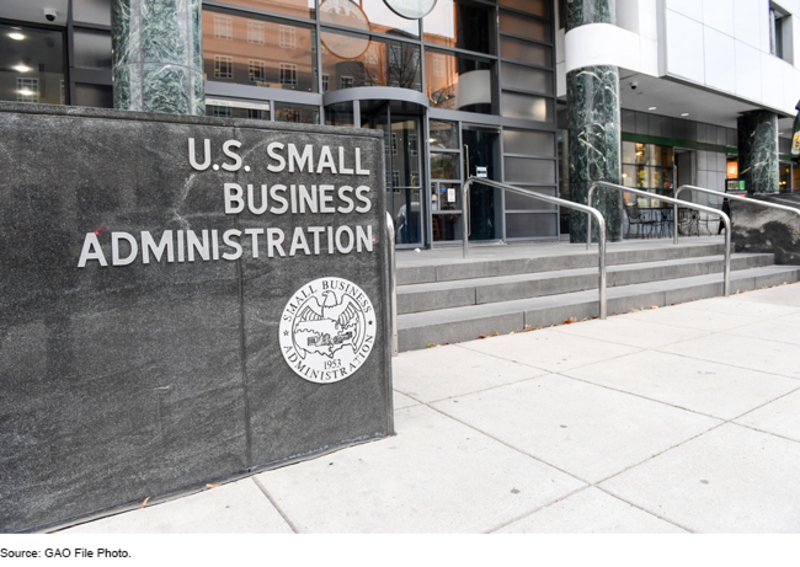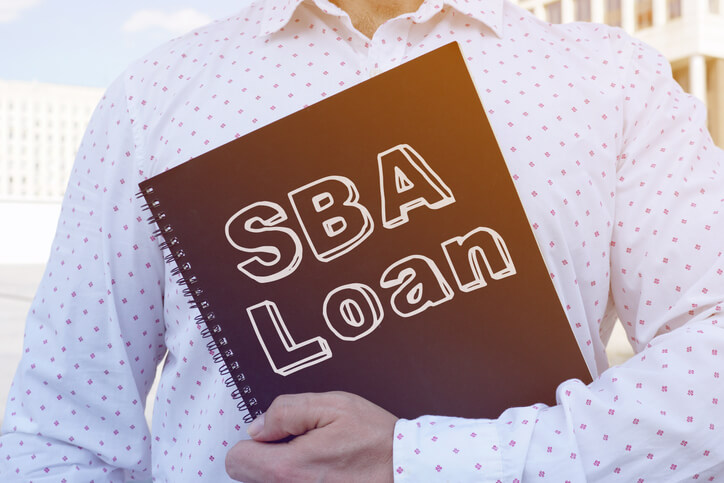From Idea to Success: How the Small Business Administration Supports Entrepreneurs
"Small businesses are the backbone of our economy, and the Small Business Administration plays a critical role in helping them succeed." - Nydia Velazquez
Brief insight
The Small Business Administration (SBA) is a U.S. government agency dedicated to supporting and promoting small businesses. The SBA provides a range of services, including financial assistance, training and counseling, and access to government contracts, to help small businesses start, grow, and succeed. Its mission is to encourage entrepreneurship, innovation, and economic growth across the country.

PHOTO: www.gao.gov/products/gao-22-104146
The Vital Role of the Small Business Administration in Supporting Entrepreneurs
The Small Business Administration (SBA) is a government agency in the United States that was established in 1953 to support and promote small businesses. The SBA's mission is to aid small businesses in starting, growing, and succeeding through the provision of financial assistance, training, and counseling, as well as access to government contracts and other resources.
The SBA offers a variety of loan programs designed to meet the financing needs of small businesses, including the 7(a) loan program, which is the agency's flagship program and provides guaranteed loans to small businesses to help them acquire capital for a variety of business purposes. Other SBA loan programs include the microloan program, which provides small loans of up to $50,000 to new and growing businesses, and the disaster loan program, which provides low-interest loans to businesses and homeowners affected by natural disasters.
In addition to providing financial assistance, the SBA offers training and counseling services to small businesses through its network of Small Business Development Centers (SBDCs), SCORE chapters, and Women's Business Centers (WBCs). These centers offer a variety of services, including business planning assistance, financial management training, marketing, and sales strategies, and help with government contracting.
Finally, the SBA also advocates for small businesses by working with government agencies and policymakers to ensure that small business concerns are heard and addressed. This includes advocating for policies that support small business growth and development and working to ensure that small businesses have access to government contracts and other opportunities.
Overall, the Small Business Administration plays a vital role in supporting small businesses in the United States, helping them to start, grow, and succeed. Its programs and services provide a lifeline to millions of entrepreneurs across the country, encouraging innovation, entrepreneurship, and economic growth.
Interesting Facts
The SBA was created in 1953 as an independent agency of the federal government. It was established to provide assistance to small businesses and promote entrepreneurship.
The SBA has helped millions of small businesses over the years. In fact, since its creation, the agency has provided billions of dollars in loans, guarantees, and other forms of assistance to small businesses across the United States.
The Evolution of the Small Business Administration: From the 1950s to Today
The Small Business Administration (SBA) was created on July 30, 1953, when President Eisenhower signed the Small Business Act into law. The Act was a response to concerns about the declining number of small businesses in the United States following World War II, and the need to create policies and programs that would support their growth and success.
Prior to the creation of the SBA, the federal government had provided limited support to small businesses, primarily through loan programs administered by the Reconstruction Finance Corporation (RFC). However, these programs were criticized for being too bureaucratic and difficult for small businesses to access.
The Small Business Act of 1953 sought to address these shortcomings by creating a new federal agency, the Small Business Administration, which would be dedicated solely to supporting small businesses. The SBA was given the authority to provide financial assistance, training and counseling, and access to government contracts, among other services.
Since its creation, the SBA has been instrumental in helping small businesses start, grow, and succeed. Its loan programs have provided billions of dollars in financing to small businesses, and its training and counseling services have helped entrepreneurs develop the skills and knowledge they need to run successful businesses.
Today, the SBA continues to play a critical role in supporting small businesses, particularly in times of economic hardship. In response to the COVID-19 pandemic, for example, the SBA launched a number of new programs, including the Paycheck Protection Program (PPP) and the Economic Injury Disaster Loan (EIDL) program, to provide financial assistance to small businesses affected by the pandemic. Overall, the Small Business Administration remains a vital resource for small businesses in the United States, helping them to overcome challenges and achieve their goals.

PHOTO: https://cdcloans.com/what-is-the-sba/
Behind the Scenes: Funding the Small Business Administration's Programs and Services
The Small Business Administration (SBA) is primarily funded through the federal government's annual budget, with funding levels determined by Congress. The agency's budget is allocated to support a wide range of programs and services designed to assist small businesses, including loan guarantee programs, counseling and training services, and advocacy efforts.
The SBA's loan programs are a major component of its funding, with the agency providing guarantees for loans made by banks and other financial institutions to small businesses. These loan guarantees help to mitigate the risk for lenders, making it easier for small businesses to access financing. The SBA charges fees to lenders for these guarantees, which help to offset the costs of the loan programs.
In addition to loan guarantees, the SBA also receives funding through various grant programs, including the Small Business Development Center (SBDC) program and the Women's Business Center (WBC) program. These grant programs provide funding to organizations that provide training, counseling, and other services to small businesses.
Finally, the SBA also generates revenue through the sale of government contracts and surplus property, as well as fees charged for certain services, such as the issuance of surety bonds.
Overall, the Small Business Administration's funding is intended to support its mission of promoting small business growth and success. While the agency's budget can fluctuate from year to year based on the priorities of Congress and the federal government, the SBA remains committed to providing essential services and support to small businesses across the United States.
Statistical Data
In the fiscal year 2020, the SBA's 7(a) loan program, which provides loan guarantees to small businesses, supported more than 44,000 loans for a total of $22.5 billion.
In the fiscal year 2020, the SBA's 504 loan program, which provides financing for real estate and other fixed assets, supported more than 6,000 loans for a total of $4.8 billion.
Inside the Small Business Administration: How Programs and Services are Administered
The Small Business Administration (SBA) is administered by a team of leaders appointed by the President of the United States and confirmed by the Senate. At the head of the agency is the Administrator, who serves as the SBA's chief executive officer and is responsible for overseeing the agency's programs, services, and operations.
The SBA is divided into several offices and divisions, each with a specific area of responsibility. These include the Office of Disaster Assistance, which provides low-interest loans to businesses and homeowners affected by natural disasters, and the Office of Government Contracting and Business Development, which helps small businesses compete for government contracts.
The SBA's loan programs are administered through a network of field offices and lending partners, including banks and other financial institutions. These partners originate and service loans, with the SBA providing guarantees to lenders to mitigate risk and encourage lending to small businesses.
In addition to its lending programs, the SBA also provides counseling and training services through its network of Small Business Development Centers (SBDCs), SCORE chapters, and Women's Business Centers (WBCs). These centers offer a range of services, including business planning assistance, financial management training, and marketing and sales strategies.
Finally, the SBA is also involved in advocacy efforts aimed at promoting small business interests at the federal level. This includes working with government agencies and policymakers to ensure that small business concerns are heard and addressed, as well as advocating for policies that support small business growth and development.
Overall, the Small Business Administration is administered through a complex network of offices, partners, and programs, all working together to support small business growth and success. Its programs and services play a vital role in helping entrepreneurs start, grow, and succeed, and in promoting innovation, entrepreneurship, and economic growth across the country.

PHOTO: https://www.pexels.com/uk-ua/@ketut-subiyanto/
A Comprehensive Guide to the Programs and Services of the Small Business Administration
The Small Business Administration (SBA) offers a variety of programs designed to support small businesses at every stage of their development. These programs include
- Loan programs: The SBA offers several loan programs to help small businesses access the capital they need to start, grow, and expand their businesses. These include the 7(a) loan program, which provides loans of up to $5 million for a variety of purposes, including working capital, equipment purchases, and real estate acquisition. The SBA also offers the CDC/504 loan program, which provides long-term, fixed-rate financing for major fixed assets such as buildings and equipment, and the microloan program, which provides loans of up to $50,000 for small businesses and nonprofit child care centers.
- Counseling and training services: The SBA provides counseling and training services to help small business owners develop the skills they need to start and grow successful businesses. This includes one-on-one counseling through the SBA's network of Small Business Development Centers (SBDCs) and SCORE chapters, as well as online training resources on topics such as business planning, financial management, and marketing.
- Contracting programs: The SBA offers several programs to help small businesses compete for government contracts. These include the 8(a) Business Development program, which provides business development assistance, mentoring, and access to government contracting opportunities to small businesses owned by socially and economically disadvantaged individuals. The SBA also offers the HUBZone program, which provides contracting preferences to small businesses located in economically distressed areas, and the Women-Owned Small Business Federal Contracting program, which provides contracting preferences to small businesses owned by women.
- Disaster assistance: The SBA provides low-interest disaster loans to small businesses and homeowners affected by natural disasters such as hurricanes, floods, and wildfires. These loans are designed to help businesses and homeowners repair or replace damaged property, as well as cover losses not covered by insurance.
- Investment programs: The SBA offers several investment programs to help small businesses access capital. These include the Small Business Investment Company (SBIC) program, which provides equity and debt financing to small businesses, and the Small Business Innovation Research (SBIR) and Small Business Technology Transfer (STTR) programs, which provide funding for research and development projects.
Overall, the Small Business Administration's programs are designed to provide critical support to small businesses at every stage of their development. Whether through access to capital, counseling and training services, contracting programs, disaster assistance, or investment programs, the SBA plays a vital role in promoting entrepreneurship, innovation, and economic growth across the United States.
Interesting Facts
The SBA operates a network of over 60 district offices and hundreds of field offices across the country. These offices provide counseling, training, and other services to small businesses.
The SBA partners with banks, credit unions, and other lenders to provide loans to small businesses. In some cases, the SBA guarantees a portion of the loan, which can help businesses qualify for financing they might not otherwise be able to get.
Understanding Eligibility Requirements for SBA Programs
The eligibility requirements for the programs offered by the Small Business Administration (SBA) vary depending on the specific program, but in general, small businesses that meet certain criteria are eligible for SBA assistance. These criteria include
- Size: To be considered a small business by the SBA, a company must meet size standards based on either its number of employees or its annual revenue. The size standards vary by industry, so it's important to check the SBA's Size Standards Tool to determine whether your business is eligible.
- Type of business: The SBA offers assistance to a wide variety of businesses, including sole proprietorships, partnerships, limited liability companies (LLCs), and corporations. However, some SBA programs may have specific eligibility requirements based on the type of business.
- Purpose of the loan: Some SBA loan programs have specific requirements regarding how the loan proceeds can be used. For example, the 7(a) loan program can be used for a variety of purposes, including working capital, equipment purchases, and real estate acquisition, while the microloan program is specifically designed to provide short-term financing for small businesses and nonprofit childcare centers.
- Creditworthiness: To qualify for an SBA loan, small businesses must demonstrate that they have a strong credit history and are able to repay the loan. The SBA typically requires collateral for loans above a certain amount, and borrowers may be required to provide a personal guarantee.
- Other criteria: Some SBA programs have additional eligibility requirements, such as the 8(a) Business Development program, which requires that the business be at least 51% owned and controlled by socially and economically disadvantaged individuals.
Overall, the eligibility requirements for SBA programs are designed to ensure that the assistance provided by the SBA goes to small businesses that are most in need of support. By targeting its programs to businesses that meet certain criteria based on size, type of business, the purpose of the loan, creditworthiness, and other factors, the SBA is able to help small businesses start, grow, and succeed, and to promote entrepreneurship and economic growth across the United States.

PHOTO: https://www.pexels.com/uk-ua/@chevanon/
The Benefits of SBA Programs: Financial Stability for Entrepreneurs
Small business owners who are eligible for assistance from the Small Business Administration (SBA) can benefit from a range of advantages and benefits. Here are some of the key advantages of working with the SBA:
- Access to capital: One of the main benefits of working with the SBA is access to capital. The SBA provides loan guarantees that enable small businesses to obtain financing that they might not otherwise be able to secure. SBA loans typically have lower interest rates and longer repayment terms than traditional loans, making them an attractive option for many small business owners.
- Counseling and training: The SBA provides counseling and training services to help small business owners develop the skills they need to succeed. This can include business planning, marketing, financial management, and more. The SBA also offers specialized training programs for women, veterans, and other underrepresented groups.
- Contracting opportunities: The SBA helps small businesses compete for government contracts through its 8(a) Business Development program and other initiatives. This can be a valuable source of revenue for small businesses, especially those that are just starting out.
- Disaster assistance: The SBA provides disaster assistance loans to small businesses that have been affected by natural disasters such as hurricanes, floods, and wildfires. These loans can help businesses recover and get back on their feet.
- Advocacy: The SBA advocates on behalf of small businesses at the federal level, working to ensure that small businesses have a voice in policy and regulatory discussions. The SBA also works to promote small business growth and entrepreneurship across the country.
Overall, the SBA provides a range of services and benefits that can help small businesses start, grow, and succeed. By providing access to capital, counseling and training, contracting opportunities, disaster assistance, and advocacy, the SBA plays a crucial role in supporting the small business community and promoting economic growth.
Statistical Data
The SBA's Small Business Innovation Research (SBIR) and Small Business Technology Transfer (STTR) programs provide funding to small businesses engaged in research and development. In the fiscal year 2020, the programs awarded over $4 billion in funding to small businesses across the country.
Limitations and Drawbacks of SBA Programs: What to Keep in Mind
While the Small Business Administration (SBA) provides many benefits and advantages to small business owners, there are also some potential disadvantages and limitations to consider. Here are a few of the most significant:
- Eligibility requirements: The eligibility requirements for SBA programs can be strict, and not all small businesses will qualify for assistance. Some programs are only available to businesses in certain industries, while others have size or revenue requirements that may exclude some businesses.
- Loan application process: While SBA loans can be a valuable source of capital, the application process can be lengthy and complex. Applicants may be required to provide extensive documentation and financial information, and the process can take several weeks or even months.
- Collateral and personal guarantees: To qualify for an SBA loan, businesses may be required to provide collateral, such as real estate or equipment. In addition, borrowers may be required to provide a personal guarantee, which means that they are personally liable for the loan if the business is unable to repay it.
- Limited funding: The SBA's budget is limited, and not all businesses that apply for assistance will be able to receive it. In addition, some programs may have limited funding available, which means that there may be a waiting list or that businesses may need to apply at a specific time of year to be considered.
- The complexity of programs: Some SBA programs can be complex and difficult to navigate. For example, the 8(a) Business Development program has strict eligibility requirements and a lengthy application process, and the process of obtaining government contracts can be challenging for small businesses.
Overall, the SBA provides valuable services and support to small businesses, but there are also some potential disadvantages and limitations to consider. Businesses should carefully evaluate their needs and determine whether SBA assistance is the right choice for them.
Last Trends in SBA Programs
Women's Business Centers: The SBA has increased its support for Women's Business Centers (WBCs) across the country. WBCs offer counseling, training, and other resources specifically tailored to the needs of women entrepreneurs.
Small Business Innovation Research (SBIR) and Small Business Technology Transfer (STTR) Programs: The SBA has increased its funding for these programs, which provide research and development funding to small businesses in technology-based industries.
Rural Business Development: The SBA has also increased its focus on supporting small businesses in rural areas. This includes funding for rural business development centers, as well as initiatives to increase access to capital and resources for rural businesses.
Step-by-Step Guide to Applying for SBA Programs
The Small Business Administration (SBA) offers a variety of programs and services to help small businesses start, grow, and succeed. Here's an overview of how to apply for SBA programs:
- Determine eligibility: Before applying for an SBA program, businesses should determine whether they meet the eligibility requirements. Eligibility varies depending on the program, but some common criteria include the size of the business, its industry, and its financial standing.
- Choose a program: Once a business has determined that it meets the eligibility requirements, it should choose the program that best meets its needs. The SBA website provides information about the various programs available, including loans, grants, and counseling services.
- Gather documentation: Depending on the program, businesses may need to provide documentation such as financial statements, tax returns, business plans, and resumes. It's important to gather all of the necessary documentation before beginning the application process.
- Apply online: Many SBA programs allow businesses to apply online. The SBA website provides a portal where businesses can create an account, fill out an application, and track the status of their application.
- Apply in person: Some SBA programs require businesses to apply in person at an SBA office. Businesses should check the requirements for the specific program they're interested in to determine whether an in-person application is necessary.
- Follow-up: After submitting an application, businesses should follow up with the SBA to ensure that their application is being processed. The SBA website provides resources for checking the status of an application and contacting SBA staff for assistance.
Overall, applying for SBA programs can be a complex process, but with careful preparation and attention to detail, businesses can increase their chances of success. It's important to determine eligibility, choose the right program, gather all necessary documentation, and follow up with the SBA as needed.
- The SBA offers a variety of programs and services to help small businesses start, grow, and succeed. These include loans, grants, counseling services, and government contracting assistance.
- Eligibility requirements vary depending on the program, but in general, small businesses must meet size, industry, and financial requirements to qualify for assistance.
- SBA programs can provide significant advantages to small businesses, including access to capital, technical assistance, and government contracting opportunities.
- However, there are also potential disadvantages and limitations to consider, such as strict eligibility requirements, lengthy application processes, and limited funding.
- To apply for SBA programs, businesses should carefully evaluate their needs, choose the right program, gather all necessary documentation, and follow up with the SBA as needed.
- Overall, the SBA can be a valuable resource for small businesses looking to start, grow, or succeed, but businesses should carefully consider their options and determine whether SBA assistance is the right choice for them.
FAQ
What types of programs does the SBA offer?
The SBA offers a variety of programs and services to help small businesses start, grow, and succeed. These include loans, grants, counseling services, and government contracting assistance.
How long does it take to receive SBA funding?
The amount of time it takes to receive SBA funding depends on the program and the specifics of the application. Some programs may be able to provide funding within a few weeks, while others may take several months.
What should I do if I have questions or need help with an SBA program?
The SBA provides a variety of resources to help businesses with questions or concerns about SBA programs. These include online resources, local SBA offices, and counseling services.
Can a startup company qualify for an SBA loan?
Yes, a startup company can qualify for an SBA loan, as long as it meets the eligibility requirements for the specific loan program. The SBA has a variety of loan programs, including the 7(a) loan program and the Microloan program, which can provide funding to startups.
Can a small business receive more than one SBA loan?
Yes, a small business can receive more than one SBA loan, as long as it meets the eligibility requirements for each loan program and can demonstrate the ability to repay the debt.
What is the maximum amount of an SBA loan?
The maximum amount of an SBA loan varies depending on the loan program. For example, the maximum loan amount for the SBA's 7(a) loan program is $5 million, while the maximum loan amount for the SBA's Microloan program is $50,000.
Can a non-US citizen apply for an SBA loan?
Yes, non-US citizens can apply for an SBA loan, as long as they meet the eligibility requirements for the specific loan program and have the necessary documentation to legally operate a business in the United States.
These FAQs provide additional information about the programs and services of the Small Business Administration and may be helpful for small business owners who are considering applying for an SBA loan or other support.